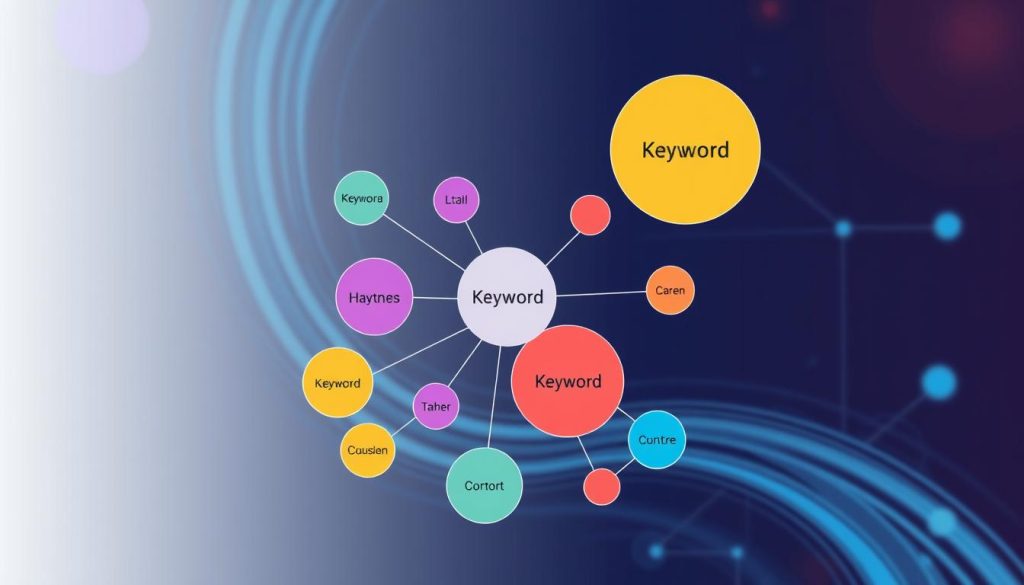As I reflect on my digital marketing journey, I’m amazed at how far we’ve come. The internet has grown, changing how we connect with people. Keywords are at the core of this change, shaping SEO.
In the early days, finding the right keywords was like searching for a needle in a haystack. Now, as a WordPress developer and SEO expert, I’m excited to share my knowledge. Let’s explore the world of keywords and how they boost your online presence.
Keywords link what people search for with the content you offer. They’re not just random words; they’re the heart of your content. They guide search engines to your site. As we dive deeper, you’ll see how mastering keywords can change your SEO game.
In this guide, we’ll cover keyword research basics and strategies. We’ll find the best keywords for your business and learn how to use them. This journey will help you improve your SEO skills, whether you’re experienced or new to marketing.
Key Takeaways
- Keywords are fundamental to connecting your content with searchers
- Effective keyword research is vital for a successful SEO strategy
- Understanding search intent is key for choosing keywords
- Long-tail keywords offer great opportunities for niche targeting
- Balancing search volume and keyword difficulty is essential for success
- Avoiding common keyword mistakes can greatly improve SEO results
What Are Keywords and Why They Matter
Keywords are key to search engine optimisation (SEO). They help connect your content with your audience. I’ll explain what keywords are, why they’re important, and how they affect your website’s visibility.
Definition and Core Concepts
Keywords are specific words or phrases people use when searching online. They link what users are looking for with the content you offer. Knowing about keywords is vital for a good SEO plan.
The Role in Search Engine Optimisation
Keywords are essential for SEO. They help search engines understand your website’s content. By using the right keywords, you can rank higher in search results. This can bring more visitors and customers to your site.
Impact on Website Visibility
Good keyword research and use can greatly improve your website’s visibility. Here are some interesting facts:
- More than 90% of online experiences start with a search engine
- Monthly Search Volume (MSV) shows how popular a keyword is
- Popular keywords often have higher search volumes
By focusing on the right keywords, you can show up in search results when people are looking for what you offer. This can lead to more visitors, sales, and business growth.
Understanding Keywords
Keywords are key to good search engine optimisation (SEO). I’ll look at the different types of keywords and how they affect your website’s visibility. Knowing these is essential for a strong SEO plan.
Keywords vary. Head keywords are broad and have lots of searches. Long-tail keywords are more specific and often match what users are looking for better.
Search intent is important when picking keywords. It’s about knowing what users want when they search. By matching your content to what users are looking for, you can make your site more relevant and engaging.
| Keyword Type | Characteristics | Benefits |
|---|---|---|
| Head Keywords | Short, high search volume | Broad reach, high competition |
| Long-tail Keywords | Specific, lower search volume | Less competition, higher conversion rates |
| Intent-based Keywords | Aligned with user goals | Improved relevance, better user experience |
Picking the right keywords is about finding a balance. You need to consider relevance, search volume, and how well they rank. Tools like Google’s Keyword Planner can help with this. Remember, using keywords well means creating content that truly meets what users are searching for.
The Fundamentals of Keyword Research
Keyword research is key to good SEO. It helps connect your content with the right people. Let’s look at what makes it important.
Identifying Your Target Audience
Knowing who you’re talking to is the first step. I imagine what words my customers might use to find what they need. This way, I make content that meets their needs and search habits.
Brainstorming Seed Keywords
Seed keywords start your keyword research. I start with broad terms about my business. These ideas help me find more specific, long-tail keywords that bring targeted visitors.
Using Keyword Research Tools
Keyword research tools are essential for finding good keywords. I use both free and paid tools to make my research easier. Here’s a look at some popular ones:
| Tool | Type | Key Features |
|---|---|---|
| Google Keyword Planner | Free | Search volume, competition data |
| Ahrefs Keywords Explorer | Paid | Keyword difficulty, click metrics |
| SEMrush | Paid | Competitor analysis, SERP features |
| Moz Keyword Explorer | Paid | Keyword suggestions, priority score |
By understanding these basics, I can find keywords that help my site get seen by the right people.
Types of Keywords Explained
Keywords are key in search engine optimisation. I’ll look at different types and how they affect your SEO strategy.
Head Keywords vs Long-tail Keywords
Head keywords are short and general, with lots of searches and competition. Long-tail keywords are longer and more specific, with fewer searches but less competition. For example, ‘mechanic’ is a head keyword, while ‘best bullet journal’ is a long-tail keyword with 4.3K monthly searches globally.
Informational Keywords
Informational keywords are often questions like ‘what’, ‘why’, or ‘how’. They help in the early stages of buying. These keywords build brand awareness and trust, even if they don’t lead to sales right away.
Commercial Keywords
Commercial keywords show a user’s intent to research brands or products. They include terms like ‘best’, ‘cheapest’, or ‘compare’. For example, ‘compare car insurance’ has a global monthly search volume of 205K, showing its popularity.
Transactional Keywords
Transactional keywords, or buyer keywords, show a strong intent to buy. They include phrases like ‘buy’, ‘subscribe’, or ‘for sale’. Users searching with these keywords are ready to make a purchase.
| Keyword Type | Example | Monthly Search Volume | User Intent |
|---|---|---|---|
| Head | Mechanic | High | General information |
| Long-tail | Best bullet journal | 4.3K | Specific information |
| Commercial | Compare car insurance | 205K | Research and comparison |
| Transactional | Buy iPhone 15 | Varies | Purchase intention |
Keyword Metrics That Matter
In the world of SEO, knowing about keyword metrics is key. I’ll look at three important metrics: search volume, keyword difficulty, and CPC.
Search volume shows how often people search for a term. It’s a key metric for checking possible traffic. But, high search volume doesn’t always mean success. You need to consider other factors too.
Keyword difficulty tells you how hard it is to rank for a term. It looks at competitors’ domain authority and backlinks. For new sites, aiming for low to medium difficulty keywords is wise.
CPC, or Cost Per Click, shows what advertisers pay for clicks on certain keywords. It’s mainly for paid ads, but it also helps with SEO’s commercial value.
| Keyword | Search Volume | Keyword Difficulty | CPC |
|---|---|---|---|
| SEO tips | 5,400 | 67 | £2.50 |
| Best running shoes | 22,200 | 82 | £1.80 |
| Homemade pizza recipe | 40,500 | 75 | £0.30 |
By looking at these metrics, you can choose the right keywords. It’s not just about high numbers. It’s about finding the right balance for your goals and resources.
Search Intent and User Behaviour
Understanding how people search online is key to making great content. Search intent is behind 70% of what people do online. It’s vital for SEO. Let’s see how to match content with intent and improve for different searches.
Understanding User Search Patterns
Search engines try to guess what users want to find. There are four main types of search intent: informational, commercial, navigational, and transactional. Each shows what users are looking for when they search.
For example, if someone searches with “What,” “How,” “Who,” or “Why,” they’re looking for information.
Matching Content to Intent
To match content with intent, look at the search results for your keywords. This shows if Google thinks the search is for information, navigation, a transaction, or something to buy. Tools like Moz Pro can help find the intent behind searches.
About 80% of searches have layers of intent. This can change what the user does next.
Optimising for Different Search Intents
To optimise for different intents, tailor your content. For informational searches, build a detailed knowledge base. For navigational searches, make your site easy to navigate.
For transactional searches, have clear calls-to-action and a smooth checkout. For commercial searches, offer detailed product pages and comparisons.
| Search Intent Type | User Goal | Optimisation Strategy |
|---|---|---|
| Informational | Seek definitions, facts, explanations | Create a detailed knowledge base |
| Navigational | Find specific website or webpage | Improve website navigation |
| Transactional | Complete purchases or actions | Clear CTAs, smooth purchasing process |
| Commercial | Research before making decisions | Detailed product pages, comparisons |
By focusing on search intent and user behaviour, you can make your content more relevant and effective. This can lead to a 50% increase in engagement and conversions.
Keyword Competition Analysis
Keyword competition analysis is key to a strong SEO strategy. By looking at the search terms your rivals use, you can gain insights to boost your own strategy.
Assessing Keyword Difficulty
When checking keyword difficulty, I look at search volume and user intent. It’s not just about how many searches a term gets. I also consider what the searcher wants. This helps me find keywords that are both reachable and relevant to my audience.
| Factor | Importance | Consideration |
|---|---|---|
| Search Volume | High | Potential traffic |
| User Intent | Critical | Relevance to audience |
| Competition Level | Significant | Ranking difficulty |
Competitor Keyword Analysis
I use tools to find keywords my competitors use but I don’t. This involves gathering their keywords, sorting them, and checking how hard they are to rank for. It helps me find new keywords to add to my strategy.
Finding Keyword Opportunities
To find new keywords, I do a keyword gap analysis. This shows me terms my competitors rank for but I don’t. I also watch for new keywords they start ranking for, which shows me trends. By focusing on valuable keywords that match my audience’s needs, I can attract more quality visitors to my site.
Effective keyword competition analysis can uncover opportunities where competitors are neglecting specific keywords, leading to improved search engine rankings and website traffic.
It’s not just about finding keywords with lots of searches. Long-tail keywords often have the right balance of search volume and less competition. By balancing these and matching user intent, I can make my keyword strategy stand out.
Strategic Keyword Placement
Keyword placement is key in on-page SEO and content strategy. I’ve seen how placing keywords wisely can boost your site’s visibility and rankings. Let’s look at where to place keywords for the best results.
The first 200 words of your content are very important to Google. It’s essential to put your target keywords in early. But do it naturally, not by forcing keywords into your content.
- Title tags: Include your target keyword and website name
- Headings: Use relevant keywords and synonyms in H1, H2, and H3 tags
- Meta descriptions: Craft engaging summaries with keywords to improve click-through rates
- Body content: Distribute keywords naturally throughout the text
- Image alt text: Describe images using relevant keywords
Keyword optimisation is more than just where you put keywords. It’s about knowing what users want and matching your content to that. This way, more visitors will stay and engage with your site.
| Search Intent Category | Description | Keyword Strategy |
|---|---|---|
| Informational | Users seeking knowledge | Use question-based keywords, focus on educational content |
| Navigational | Users looking for specific websites | Optimise for brand-related keywords |
| Commercial | Users researching products or services | Use comparison keywords, highlight product features |
| Transactional | Users ready to make a purchase | Include action-oriented keywords, focus on conversion |
By using these smart keyword placement strategies, you can boost your on-page SEO. And make content that appeals to both search engines and users.
Long-tail Keywords and Their Value
Long-tail keywords are key to search engine optimisation. They are specific phrases that make up a big part of online searches. They offer great chances for targeting specific niches and improving conversions.
Benefits of Long-tail Keywords
Long-tail keywords are valuable because they are specific and have less competition. For example, ‘sushi’ is very competitive, but ‘sushi sandwich recipe’ is easier to rank for. This leads to better conversion rates.
Finding Long-tail Opportunities
I find long-tail keywords using different tools. Google’s autocomplete and Semrush’s Keyword Magic Tool are great places to start. A keyword gap analysis can also show what your competitors are doing well.
Implementation Strategies
To use long-tail keywords well, you need a careful plan. I make sure they fit naturally in the content, matching what users are looking for. For local businesses, adding ‘near me’ can really help target local customers.
| Keyword Type | Search Volume | Conversion Rate | Competition |
|---|---|---|---|
| Head Keywords | 10-15% | Low | High |
| Mid-length Keywords | 15-20% | Moderate | Moderate |
| Long-tail Keywords | 70% | High | Low |
Using long-tail keywords has really helped me improve targeting and conversions. Success comes from knowing your audience and creating content that meets their needs.
Keyword Clustering and Organisation
Keyword clustering is a key method in content organisation and semantic SEO. It groups related keywords to make content that meets user needs and boosts search rankings. Pages using keyword clustering can rank for about 2,200 keywords. They attract roughly 183,100 organic visits monthly from the U.S.
When using keyword clustering, it’s important to think about the four main search intents:
- Informational
- Navigational
- Commercial
- Transactional
Aligning your content with these intents helps create topic clusters for different user needs. This method not only strengthens your SEO but also enhances the user experience on your site.
When evaluating keyword groups, I look at SERP similarity, content quality, and user journey. It’s also key to note that optimising existing pages is quicker and easier than creating new ones. This insight is very useful when planning your content strategy.
| Metric | Value |
|---|---|
| Organic traffic increase to blog section | ~1,250% in 6 months |
| Keywords collected on “dining tables” topic | Over 10,000 |
| Pages required for clustered keywords | ~300 |
By focusing on keyword clustering and strategic content organisation, you can greatly increase your website’s visibility and organic traffic. Always check your rankings with Google Search Console to see how well your keyword clustering strategy is working.
Tools and Resources for Keyword Research
Having the right tools for keyword research can change everything in SEO. I’ve looked at over 80 tools to help you find the best ones for your needs.
Free Keyword Research Tools
For beginners, free tools are a great start. Google Keyword Planner is free and helps with budgeting for Google Ads. It lets you sort keywords by brand or non-brand and gives up to 1,184 ideas per search.
Moz Keyword Explorer is another free tool worth checking out. It gives 10 queries a month with up to 1,000 suggestions each. It also has easy-to-understand metrics for keyword difficulty and domain authority.
Premium SEO Tools
For more advanced features, tools like Semrush and Moz Pro are top choices. Semrush gives detailed keyword data and advanced SEO tools. Moz Pro starts at £79 a month, with 150 keyword queries allowed.
| Tool | Free Features | Premium Features |
|---|---|---|
| Google Keyword Planner | Unlimited searches, forecasting | N/A |
| Moz Keyword Explorer | 10 queries/month, 1,000 suggestions/query | 150 queries/month, advanced metrics |
| Semrush | 10 analytics reports/day, 10 tracked keywords | Extensive data, SERP analysis |
Google Search Console Integration
Google Search Console is key for understanding your site’s keywords. It shows your top 1,000 organic keywords. This helps spot areas for improvement.
By using these tools, you’ll be ready to do deep keyword research. This will help boost your website’s visibility and organic traffic.
Common Keyword Research Mistakes
I’ve seen many mistakes in keyword research that can stop SEO success. Let’s look at these common errors and how to steer clear of them for better search engine optimisation.
Keyword Stuffing Pitfalls
Keyword stuffing is an old trick that can hurt your rankings. It’s better to blend keywords naturally. A study found that content with more than 2% keyword density can get flagged as spam, making it harder to be seen.
Ignoring Search Intent
Understanding search intent is key. Many sites only aim for informational keywords, missing out on sales. For example, ‘buy perfume’ and ‘shoe wholesale’ are better for making money than just giving info.
Poor Keyword Selection
Picking the right keywords is essential. Don’t just go for the most competitive ones. Long-tail keywords have less competition and can lead to more sales. For instance, ‘fitness routines for retired people’ is easier to rank for than ‘fitness’.
| Keyword Type | Competition | Conversion Rate |
|---|---|---|
| Head Keywords | High | Low |
| Long-tail Keywords | Low | High |
Effective keyword selection means finding a balance between search volume, competition, and relevance to your audience. By avoiding these common mistakes, you’ll be on the right path for a successful SEO strategy.
Conclusion
In this guide, we’ve looked at how a strong keyword strategy is key to SEO success. As a WordPress developer and SEO expert, I’ve seen how good keyword research can change digital marketing. Understanding search intent and using long-tail keywords are all important for getting your site seen.
Going from knowing your audience to using keywords well is a big step. It’s about understanding what users want and making content that meets their needs. It’s not just about pleasing search engines; it’s about giving value to your audience. And don’t forget, avoiding keyword stuffing is just as critical as picking the right keywords.
As we finish, I urge you to use these tips in your digital marketing plan. Whether you’re improving what you do or starting fresh, these methods will help. And if you want to work on SEO projects, I’m ready to collaborate. By using these keyword strategies, you’re on the path to better online visibility and reaching your business goals.













